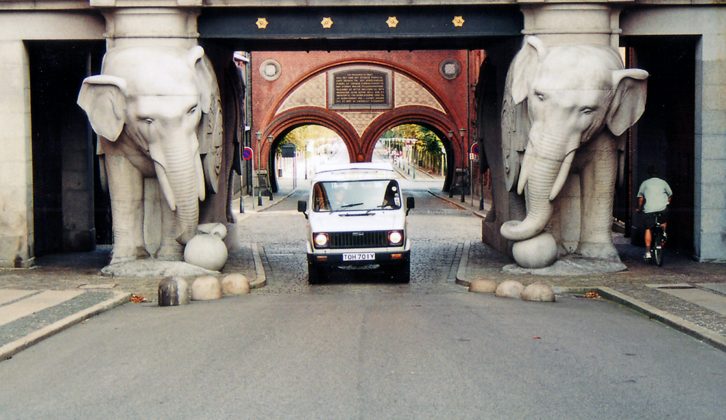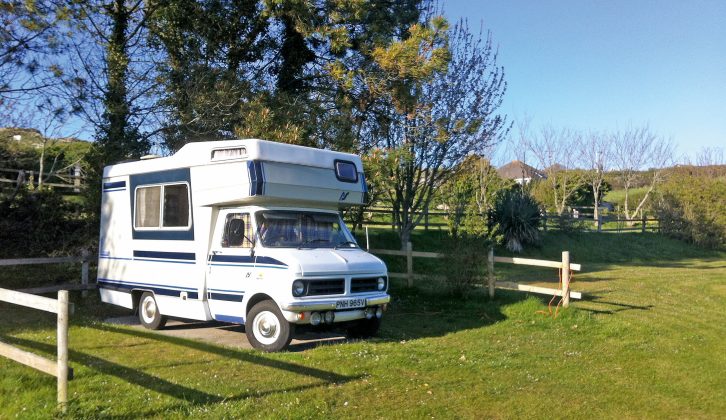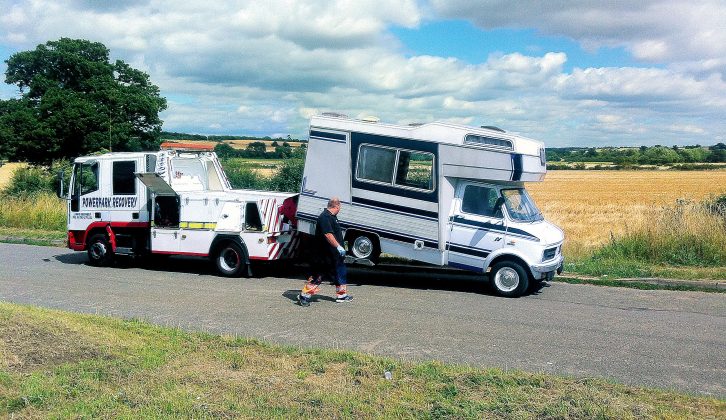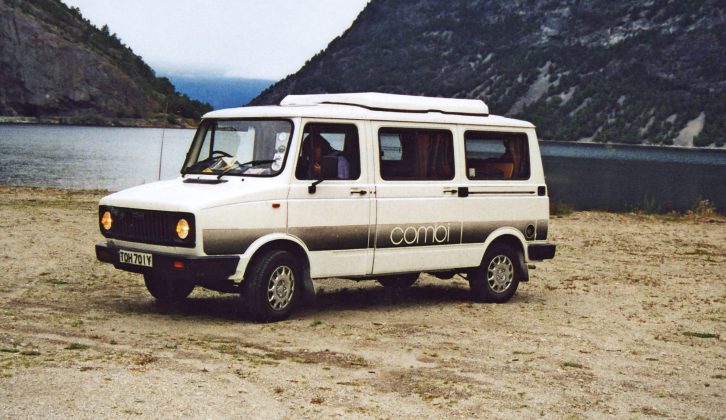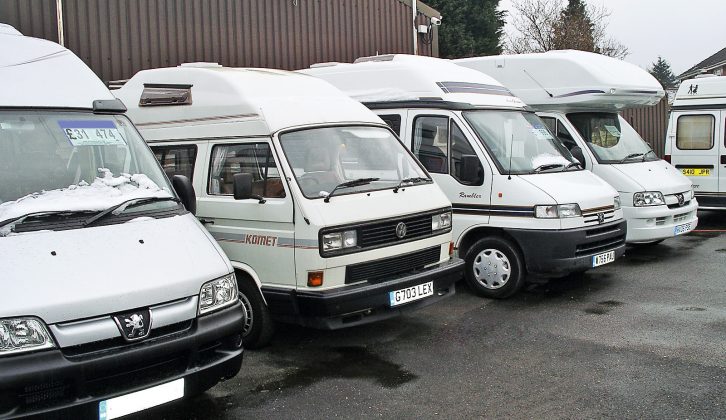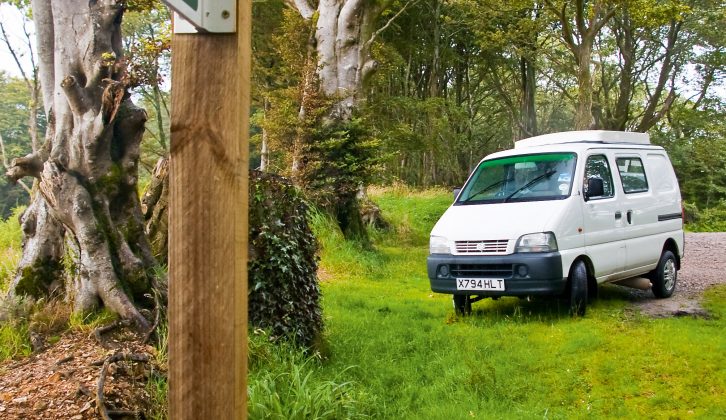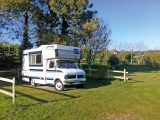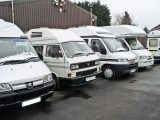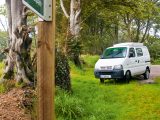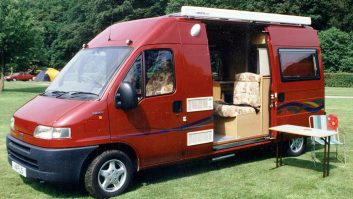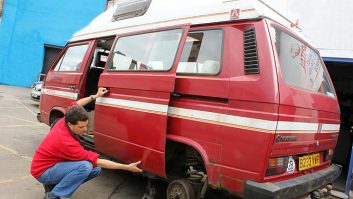In an ideal motorcaravanning world, everyone would have a new motorhome. The latest motorhomes have loads of kit, are good to drive, reliable, economical and some of them even look quite nice. There is nothing not to like. Apart from the cost.
Lots of people appreciate the value of a motorhome as a means of enjoying holidays, with the freedom of spontaneous travel to beautiful destinations. Some find that buying a motorhome can change their life for the better. But motorhome purchase prices shock many potential buyers into considering other pastimes instead. Starting prices for new motorhomes are a serious obstacle, but the prices asked for pre-owned motorhomes can be shockingly steep, too.
The seemingly extortionate cost of new motorhomes (see our new motorhome reviews for prices) pushes people into the used market, which further stokes demand. Low supply and high demand slow depreciation and cause a scarcity of late-model used bargains; in fact, they are simply not around.
Bangernomics for beginners
There is a solution in the world of motoring in the form of ‘Bangernomics’, a term coined by motoring journalist James Ruppert. (The Bangernomics Bible, James Ruppert, £8.99; PDF £1.97.)
He advises that the most economical way to run a car is not to buy new, suffer the depreciation and invest lump sums every so often to get a better one. That is the expensive way to do it.
Ruppert advocates buying an older model, letting someone else take the depreciative hit so you can reap the reward of the previous owner’s investment. Spending money where required on maintenance to keep the vehicle safe, legal and usable is part of the deal. So is living with the odd non-critical fault. The final part of the Bangernomics doctrine is when a large repair bill comes along that renders the vehicle uneconomic to repair; you do the difficult thing and walk away.
Ruppert’s pragmatic programme of motoring on a budget has some valuable lessons for those seeking a route into motorhome ownership, albeit with a few amends to suit the peculiarities of the market.
Do motorhomes depreciate?
One peculiarity of the motorhome market is depreciation or lack thereof. Motorhomes do depreciate, of course, but compared with a family car, they perform exceptionally well. For example, in the car market, a model that is very resistant to depreciation, such as a BMW 520d, would have cost you £34,795 to buy new in 2014. After three years, it would retain 47% of that value, meaning your BMW would be worth £16,353. In car terms, that is very good.
On the motorhome market, 47% retained value would be considered catastrophic. A typical budget, British coachbuilt can be yours from around £40,000. The same rate of depreciation in a motorhome would have it valued at £18,800 after three years. Anyone who has been motorhome shopping recently will have found precisely no three-year-old motorhomes available for that sort of money. In fact, at that level, you will be looking at motorhomes of around 10 years old.
Typically, motorhomes retain around 70% of their value after three years, putting somewhere closer to £25,000 as a more realistic screen price. The reasons for this are simple. Lots of people want to own motorhomes, but not many can afford to buy new, so this pushes prices of used models up.
A perfectly reasonable starting budget of £10,000 will have you looking at vans approaching the start of their third decade. The thought of sinking a five-figure sum into a vehicle of that age can be an unappealing prospect but that is because you are thinking about your motorhome adventure in the wrong way.
Less motor, more home
The first thing to get out of your head is that a motorhome is like a car. It is not. A motorhome is a high-cost asset that depreciates slowly, but with the appropriate level of care and investment will carry on doing the job it was designed to do. Ostensibly, that job is to keep you warm and dry, and fed and watered while on holiday. That description has a lot more in common with a house than it does a car.
Charles Ware, owner of the Morris Minor Centre in Bath, wrote a book in 1982 called Durable Car Ownership, in which he extolled the virtues of treating cars (Morris Minors, actually) in the same manner as a house. He argued that people do not throw away buildings. They maintain, repair, rebuild and refurbish them and keep them serviceable. You can download the Durable Car Ownership pdf here, for free.
Once a motorhome reaches a certain age, condition is far more important than layout, specification, engine configuration or pretty much anything else.
An old motorhome in good condition will never depreciate.
Think of a motorhome, with its washroom, bed, lounge and kitchen, as a house rather than a car and a lot of the accepted wisdom goes out the window. The idea of buying an older property does not repel people in the same way that buying an older motorhome does. That is because buyers think of them as motor vehicles.
Car buyers are influenced by fashion, attractive short-term finance and the fact they are broadly bought to achieve lots of different tasks. Going to the shops, visiting family, commuting and loading up for a trip to the dump are all tasks that hard-working family cars have to take on.
Motorhomes do not need such a broad base of talents. Like a house, motorhomes have a singularity of purpose: they are for holidays. To a greater extent, the quality of holiday you enjoy has very little to do with the ’van. It has a lot more to do with the weather, the destination and the company. There is no reason why a properly maintained older vehicle cannot provide the same quality of holiday as a newer one.
Plan for failure
The advantage of buying an older model is pretty apparent: spending less on the initial purchase of an older model leaves more money for holidays. Older models, by nature, are more likely to suffer unplanned problems and breakdowns, but by keeping on top of maintenance and budgeting for repairs, ongoing costs can be controlled, too. A lot of reliability problems with older vehicles (and houses for that matter) are due to poor maintenance and repair in the past. These ongoing costs will be higher than with a modern motorhome. The total amount will still be considerably less than the depreciation on a more up-to-date vehicle.
The key to staying happy with a cheaper motorhome is managing expenditure. Certain costs are predictable and can be budgeted for accordingly. For example, insurance and road tax need to be considered for any motorhome, as does the cost of filling the fuel tank. A good-quality breakdown policy is a must, too.
On top of those expenditures, you must be ready for when your older vehicle has problems, which is more likely to occur than with newer ’vans. If you prepare yourself mentally and financially, it will be far easier to cope.
If you are running an older vehicle, set money aside to cover the cost of unexpected repairs. As a general rule, £1000 will fix pretty much anything; for cheaper vehicles, reserve around 25% of the van’s value. That sounds a lot, but if you had an expensive component failure, such as an engine or a gearbox, that money would soon be spent. Similarly, if bodywork repairs are required, large sums of money will evaporate quickly.
The main reason to set funds aside is to spend money on ongoing maintenance and improvement as you do with a house. With your home, you replace major items when they fail, but for most maintenance tasks, you complete them when you notice an improvement is required. If your washing machine breaks, you replace it. But you don’t wait for your front door to rot off its hinges before you think about a coat of paint.
Do your own (motor)home survey
A vital tenet of this approach to motorhome ownership is knowing your vehicle well and being able to predict or prevent failure.
A basic survey of your motorhome when you first get it will allow you to build a picture of tasks that require attention. Spend a day going around the ’van, making notes, taking pictures and looking for potential problems.
If the chassis outriggers are coated in surface rust, the cab doors are going a bit scabby, one of the windows is clouding up or the water pressure is low, note these problems.
None will stop you from using the ’van and none represents a safety issue, but fixing them all at the same time would be expensive or lay the ’van up for very long. Instead, grade the problems. The most urgent can be attended to and fixed first. Others can be left until the winter, next year or even indefinitely if they don’t worry you.
By knowing your vehicle well, regular maintenance and repairs can be planned and budgeted for. This minimises the chances of a breakdown and ensures that, through a process of gradual improvement and updating, your vehicle does not depreciate. It may even increase in value.
Browse through Practical Motorhome‘s advice articles on running an older motorhomes, from replacing a leaky roof vent to sorting out your batteries, upgrading the lighting, taking care of your turbocharger and more.
End of days
The tough bit for many people about such a pragmatic approach to motorhome expenditure is that there will come a time when your much-loved, well-travelled old friend will become a burden too heavy to bear. Typically with motorhomes, it will be rot – wood or metal – which signals the end of the road, at least economically, for your van.
This is a place, however, where ‘Bangernomics’ and Campernomics diverge. Cars are in plentiful supply; motorhomes are not. A motorhome, no matter what ailment has befallen it, will have a market. Someone will be happy to tackle a meaty repair as a DIY project in order to get a foot on the motorhoming ladder.
How to choose your campernomic vehicle
- It’s hard to say exactly how a good vehicle looks, because it depends on the individual. Completely hands-off ownership is tricky to achieve on a budget, but not impossible. Affordable modern machinery, such as the Mazda Bongo, for example, needs little aside from periodic oil and coolant checks to keep it healthy between services. Older Talbot, BL and Ford models, on the other hand, need a fairly constant eye on simple mechanical systems to keep them working happily.
- Our Practical Motorhome used ‘van buyer’s guides are a good place to start browsing for older campervans, making a note of the pros and cons of each model, with a rough guide as to the price you can expect to pay for one. For instance we have guides to buying a used 2005-2010 Knaus Sun TI, a 1994-2000 Auto-Sleeper Duetto, a Romahome Dimension R30, and a used 1995-2006 Hymer A-Class motorhome and many more.
- Once you have a basic idea of what you want, you can start the fun bit, which is looking for potential vehicles. These days, the large motorhome dealer sites don’t tend to stock much affordable stuff, but smaller, privately owned dealers can often have tidy, older vehicles tucked away. As with so many things these days, online classified and auction sites are a great place to start the search. Why not start by browsing for new and used motorhomes for sale with Practical Motorhome‘s classified advertisement section?
- Motorhome pricing is a simple matter of supply and demand. Lots of people would like a motorhome, so there is demand. Far fewer, however, have the financial might to buy one outright. Plenty of people don’t like the idea of entangling themselves in long-term finance deals to bankroll one either. That means the supply of new motorhomes into the top of the sales funnel is relatively low.
Five things to walk away from
- Terminal rust. Anything can be fixed, of course, but once a cheap camper or motorcaravan gets overtaken by rust, the route back to roadworthiness is long and littered with expense. Unless you are a competent welder, avoid vehicles with serious rust in structural areas.
- Serious water ingress. Damp is a fact of life for older coachbuilts and you won’t avoid it completely. In some, however, the damp may have spread too far, particularly if it results from porous body panels rather than localised damage.
- Accident-damaged coachbuilts. Getting body panels and mouldings for older coachbuilts is very tough. Unless you are happy to remodel and rebuild it yourself, accident-damaged coachbuilts are best left to the professionals.
- Overpriced VW campervans. Old Volkswagen buses rot and break down, but it doesn’t stop people passing off complete rubbish as something worth buying. Don’t pay over the odds for a project ‘van just because it’s from Wolfsburg.
- Terrible self-builds. The definition of a self-build motorcaravan is pretty sketchy. But watch out for people chucking a mattress and a camping stove in a panel van, calling it a motorhome and adding 50% to the asking price – eBay is full of them.
Campernomic champions
When you’re looking at motorhomes for sale the same limitations apply to people spending £50,000 or £500. What can you fit on your drive or storage pitch? What sort of touring do you want to do? And so on.
Once you have an idea of the sort of vehicle you’d like, go shopping. When looking for affordable models, keep an eye out for our favourite base vehicles.
Bedford CF/CF2 (1969-1986)
The venerable Bedford was used as a basis for campers and coachbuilt motorhomes. Some parts are a little scarce, but rugged, separate chassis construction and simplicity mean they remain a viable basis for a running motorhome project, over 40 years since the first ones rolled off the production line. Models with petrol engines are more civilised than diesels.
- Best bit: Still quite a few about
- Worst bit: Rust, plus some issues with the availability of spares
Ford Transit Mk1/2/3
The Ford Transit is tough, easy to fix and surprisingly civilised to drive, but they rot away easily and rust is the main enemy. Lots of older coachbuilt bodies have been put on later Transit chassis to counteract the rust menace. Find a good one, though, and you’ll have a motorhome for life.
- Best bit: Easy to get parts, mechanically simple
- Worst bit: Rust
Talbot/Peugeot/Fiat Ducato Mk1
The front-wheel drive Sevel range of ’vans are easily the most numerous in the £5000-£10,000 shop window. (Read our Ducato/Boxer buyer’s guide.) Don’t buy a rusty one, don’t panic about the awful gear change (‘they all do that, sir’) and do consider a left-hand drive model, because they can be great value.
- Best bit: Loads of them are about
- Worst bit: Rust, gear change
Volkswagen T25/T3
The VW ‘wedge’ campervan models are gaining value fast as the ‘splitty’ and ‘bay-window’ ’vans creep out of range for budget buyers. Later water-cooled models are refined and rust-resistant but more complex. Early air-cooled ones are noisy but simple. You won’t lose money on a good one if you look after it.
- Best bit: Nicely made, loads of choice
- Worst bit: Expensive, early models rust
Mazda Bongo/Ford Freda (1995-2005)
All Bongos arrived as private Japanese imports from the late-1990s onward. They’re cracking value, with diesels, automatics and 4x4s available. They are quite small, so they’re not ideal if you need loads of space, and they’re prone to rust and head-gasket failure.
- Best bit: Modern, affordable, numerous
- Worst bit: Rust, short on space
Leyland Sherpa / LDV 200/300/400
The whole family of Sherpa vans shares the same pluses and minuses, regardless of age. All are pretty heavy and feel a generation behind the equivalent Transit. They are fairly rare as motorhome base vehicles but are cheap and are tough.
- Best bit: Tough, cheap, parts easy to find
- Worst bit: Dated to drive, rust
Mercedes TN ‘Bremen’ (1978-1995)
These old Mercedes vans are as tough as teeth, and if you happen upon a healthy one, it’s worth stretching your budget. They feel dated and a test drive is essential to make sure you are comfortable with the heavy controls.
- Best bit: Very tough, big
- Worst bit: Rust, dated drive
Renault Trafic (1981-2000)
The front-wheel-drive rot box was popular as a van conversion in the 1980s. Rust repairs are tricky due to the lightweight construction. The price on a fit one may be tempting. Invest in rust prevention.
- Best bit: Good to drive, mechanically simple
- Worst bit: Rust, some structural repairs difficult
We hope our Campernomics article has reassured you that you won’t lose money when you invest in your motorhome dreams. Happy browsing!
An old motorhome in good condition will never depreciate
